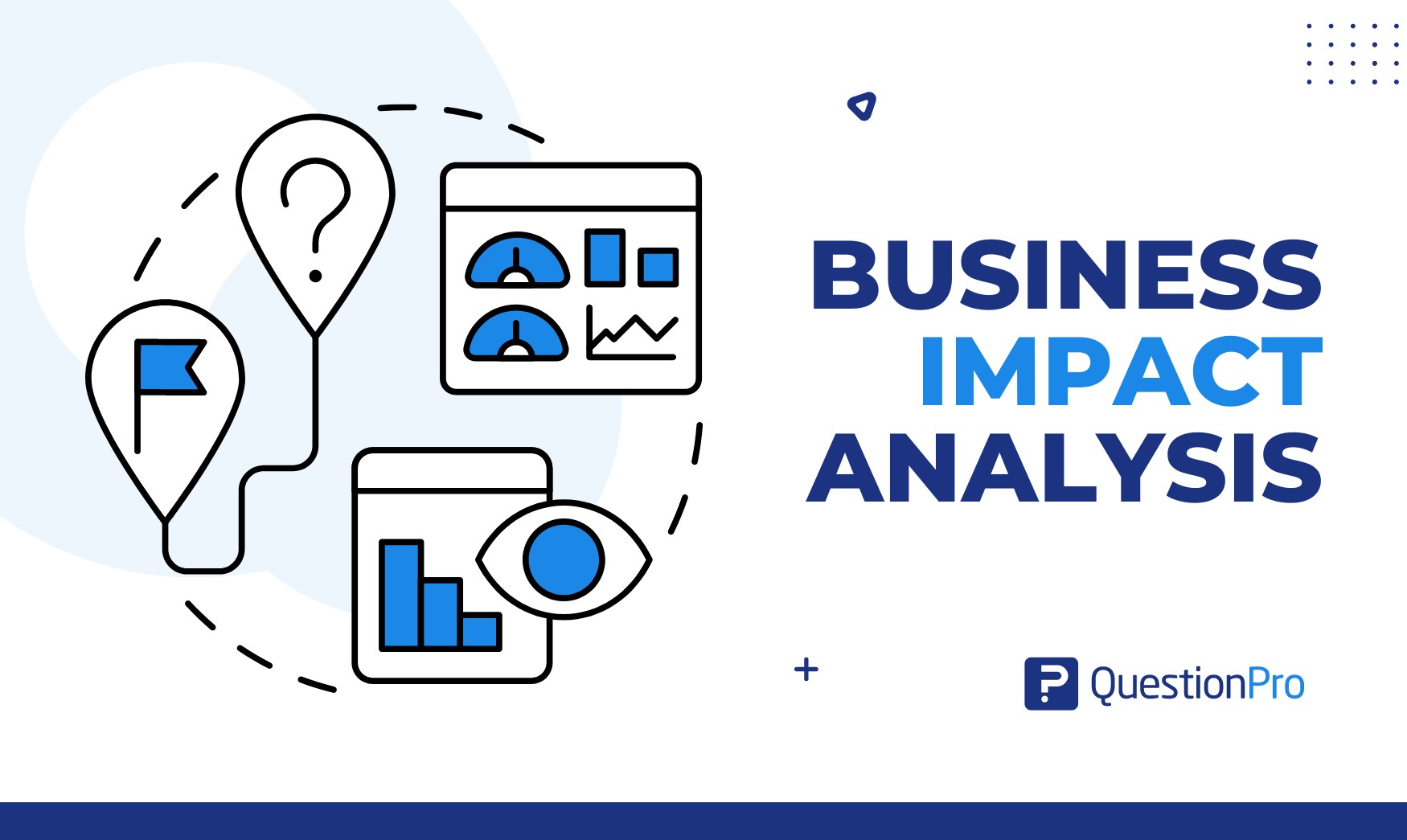
Business Impact Analysis (BIA) is like a careful examination that businesses do to understand how different problems or disruptions might affect their important activities. The main goal is to figure out which parts of the business are most crucial and need the most attention to keep things running smoothly.
It is like making a detailed plan to understand, prepare for, and deal with problems so that a business can keep running smoothly even when unexpected things happen.
In this blog, We will discuss what Business Impact Analysis is and also explore some key steps to conduct one.
What is Business Impact Analysis?
Business Impact Analysis is a systematic process that helps businesses understand what’s most important for their day-to-day operations, how disruptions could affect those operations, and what needs to be done to recover quickly and effectively. It’s a crucial part of overall business continuity planning.
It is a method that businesses use to understand and assess the potential consequences of disruptions or incidents on their essential operations. The main purpose of a BIA is to identify the critical business functions and prioritize resources to minimize the impact of any unexpected events.
Advantages of Business Impact Analysis
Business Impact Analysis (BIA) is not just a step in your business continuity plan (BCP); it’s a foundational tool that offers numerous benefits in preparing for and managing potential disruptions. Let’s delve into the advantages of incorporating BIA into your business strategy.
Recovery Process Enhancement
Your BCP should align with the priorities identified in your BIA. By understanding the impact of a business disruption on various business functions, you can enhance the recovery process. The BIA acts as a compass, pointing out areas where your BCP can be strengthened.
Organized Recovery Procedures
In times of crisis, a well-defined disaster plan is essential. The BIA helps in organizing recovery procedures by establishing a clear order of priority. It enables you to rank tasks based on their impact, ensuring a structured and efficient recovery process.
Effective BCP Testing
BIA provides a roadmap for prioritizing areas to test in your BCP. You can conduct meaningful tests by focusing on critical and high-priority assets identified in the BIA. This targeted approach allows you to assess the readiness of your business to face potential challenges.
Measuring Testing Effectiveness
A robust BIA offers metrics to evaluate the effectiveness of your BCP testing. By comparing recovery times during testing to the Maximum Tolerable Downtime (MTD), you gain insights into areas that may need improvement. This iterative process ensures that your BCP remains effective and aligned with your business goals.
Rational Backup Rotation
Understanding the impact of disruptions on critical assets allows for a rational approach to backup rotation. The BIA helps assess whether your backups align with the recovery point objectives. This insight enables your IT staff to set backup schedules and rotations that truly support your business’s recovery needs.
BIA serves as a strategic guide, offering clarity and direction in the often complex landscape of business continuity planning. Its benefits extend beyond a checklist, providing actionable insights that empower businesses to recover from disruptions and continually improve their resilience.
Integrating BIA into your annual activities lays a solid foundation for a comprehensive and effective business continuity plan.
Business Impact Analysis vs. Risk Assessment
Business Impact Analysis (BIA) and Risk Assessment are both critical components of an effective business continuity and risk management strategy. While they share similarities, they serve distinct purposes in understanding and managing potential organizational disruptions and threats.
Business Impact Analysis (BIA)
- Purpose: BIA primarily focuses on understanding the impact of disruptions on critical business functions. It aims to identify and prioritize these functions, ensuring that human and technology resources are allocated effectively during recovery efforts.
- Scope: BIA zooms in on the specific processes and functions crucial for the business’s day-to-day operations. It assesses the financial, operational, and reputational consequences of disruptions to these functions.
- Focus: The primary focus of BIA is on the operational aspects of the business. It helps determine the Recovery Time Objectives (RTO) and resource requirements necessary to resume critical operations.
- Outcomes: BIA results in a clear understanding of the order of priority for recovery, providing a foundation for building business continuity plans and ensuring the swift recovery of essential business functions.
Risk Assessment
- Purpose: It is a broader evaluation that looks at potential threats and vulnerabilities across the organization. It aims to identify, analyze, and prioritize risks that could impact various aspects of the business.
- Scope: It considers a wide range of potential risks, including external and internal factors that could pose a threat to the organization. This may include financial risks, operational risks, regulatory compliance risks, and more.
- Focus: While It considers the impact of risks on business operations, it also delves into strategic, financial, and compliance-related risks. It provides a holistic view of potential threats to the organization.
- Outcomes: The outcomes of this Assessment include a comprehensive understanding of the organization’s risk landscape, allowing for the development of risk mitigation strategies and the prioritization of risk response efforts.
Key Differences
- Focus Area: BIA focuses specifically on the impact of disruptions on business functions and the recovery process. In contrast, Risk Assessment looks at a broader spectrum of risks that could affect different aspects of the organization.
- Scope: BIA is more operationally oriented, while RA considers risks across various dimensions, including strategic, financial, and compliance-related aspects.
- Timing: BIA is often performed as part of business continuity planning, with a focus on recovery strategies. On the other hand, risk assessment is an ongoing process that addresses risks throughout the organization’s lifecycle.
BIA and Risk Assessment are critical business processes contributing to comprehensive risk management and business continuity strategy. BIA is essential for understanding the specific impact on critical functions, while Risk Assessment provides a broader view of potential risks across the organization. Both are vital components for building resilience and ensuring the long-term success of an organization.
How to Conduct a Business Impact Analysis?
Conducting a Business Impact Analysis (BIA) is crucial in preparing your business for unexpected challenges. Here’s a simple guide on how to conduct a BIA:
Step 1: Define the Scope of Your Business Impact Analysis (BIA)
Understanding the purpose of the BIA and ensuring your team is well-equipped for the process is the first crucial step.
Clearly identify what aspects of your business you aim to protect, determine the required level of business continuity, and establish who should be involved in the BIA process. Emphasize that this is not a mere checkbox activity; the results will directly influence actionable steps.
Step 2: Collect Information Through Interviews, Questionnaires, and More
Utilize interviews and questionnaires as essential tools in your BIA. Avoid the common mistake of viewing BIA as solely an IT project; it should involve the entire company.
Representatives from various departments bring insights into tool usage, workflows, workarounds during downtime, and the financial impact. Incorporate a company-wide effort for a comprehensive understanding.
Step 3: Evaluate the Data
Assess the information gathered during BIA interviews to prioritize and tier your applications/services for recovery.
Establish a schedule for reviewing and updating your BIA, Disaster Recovery Plan, and Business Continuity Plan in response to changes in your environment. Explore emergency planning resources provided by the US government for additional support.
Resources:
- Plan Ahead for Disasters
- Business Impact Analysis
- Business Impact Analysis Worksheet
Step 4: Create a BIA Report to Document Findings
BIA reports may vary, but most follow a standard structure. Include an executive summary, define objectives and scope, outline the data collection method, summarize results, break down effects on each department, attach supporting documents, and, most importantly, provide recommendations.
Beyond its role in Disaster Recovery Planning, a business impact analysis report becomes a valuable tool for understanding service consumption and criticality across business units.
Step 5: Present Findings to Senior Management
After investing time and resources into research, it’s time to present your BIA findings to senior management. Share a summary of key activities, resource requirements, and identified risks.
Explore a thorough analysis of the implications and long-term effects on the business. Offer actionable recommendations and ensure alignment with recovery times and implementation plans for key risks. Quantify operational and financial impacts in terms of dollars, time, or productivity lost due to potential disasters. Seek buy-in from executive leadership and stakeholders to move forward effectively.
Learn How QuestionPro Can Help
Business Impact Analysis (BIA) is a critical process for understanding and mitigating potential disruptions to your organization’s operations. Incorporating an effective survey tool like QuestionPro can significantly enhance the BIA process. Here’s how QuestionPro can be instrumental in conducting a thorough and efficient Business Impact Analysis:
- Customizable BIA Questionnaires: QuestionPro allows you to create customized BIA questionnaires tailored to your organization’s specific needs. Design questions that explore important business functions, dependencies, and potential impact scenarios.
- Comprehensive Data Collection: Utilize various survey methods offered by QuestionPro, including online surveys, interviews, and offline surveys. Gather data from different stakeholders, ensuring a holistic view of your organization’s operational landscape.
- Stakeholder Involvement: Engage representatives from various departments in the BIA process. QuestionPro’s survey capabilities enable easy distribution and collection of responses, ensuring a company-wide effort in understanding critical workflows and dependencies.
- Risk Assessment and Prioritization: Leverage QuestionPro to assess and prioritize risks associated with each critical business function. Use the survey results to identify potential scenarios, the likelihood of occurrence, and their impact on different aspects of your organization.
- Analysis and Reporting: QuestionPro provides robust analysis and reporting features. Utilize these tools to evaluate the data collected during the BIA interviews. Identify patterns, prioritize functions, and gain insights to support decision-making in the recovery planning phase.
- Iterative Review and Updates: Implement QuestionPro’s survey schedule features to ensure regular reviews and updates to your BIA. As your business environment evolves, use the tool to adapt your BIA questionnaire and capture changes in dependencies, risks, and critical functions.
- Solution Process: After completing the BIA interviews and data assessment, QuestionPro supports the solution process. Evaluate and select appropriate technologies that align with your organization’s Recovery Point Objectives (RPO) and Recovery Time Objectives (RTO).
- BIA Reporting: Utilize QuestionPro’s reporting features to create a structured BIA report. The tool facilitates the inclusion of an executive summary, objective and scope, data collection methods, results summary, departmental breakdowns, supporting documents, and actionable recommendations.
- Senior Management Presentation: Presenting BIA findings to management is simplified with QuestionPro. Use the tool to compile key activities, resource requirements identified risks, and thorough analyses. Quantify impacts and provide actionable recommendations for risk treatment.
Exploring QuestionPro into your Business Impact Analysis process can streamline data collection, enhance analysis capabilities, and facilitate effective communication with stakeholders. With its versatile features, QuestionPro empowers organizations to conduct comprehensive BIAs and build resilient business continuity plans.
Conclusion
Business Impact Analysis is your business survival guide. It’s not just about getting through tough times; it’s about thriving despite them. So, grab your business compass, understand what keeps your business beating, and face challenges with confidence.
Using a tool like QuestionPro makes the BIA process easier. It helps you create customized questionnaires, collect data from different people, involve everyone in the process, assess and prioritize risks, analyze your findings, and present them in a structured report. QuestionPro is like having a helper that makes sure you don’t miss anything important.







